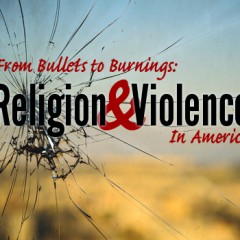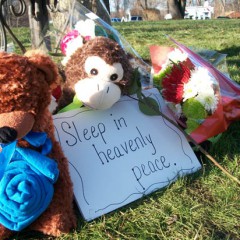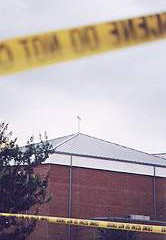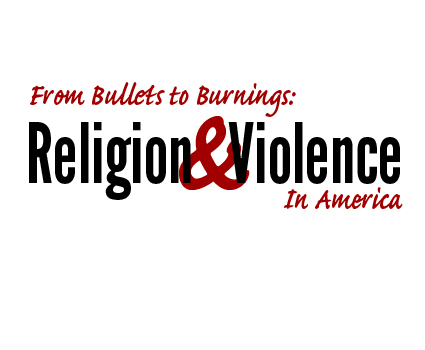This week, Faith & Values news will explore what happens when violence crosses thresholds in churches, synagogues and mosques. Though deadly shooting incidents happen every week in public spaces, have these incidents become more commonplace in the holiest of places? How are houses of worship responding and preparing to defend themselves from intruders and attacks? To answer these questions, we’ll look at five cities in America and the painful realities, lessons and decisions taking place each day to keep worshipers safe.
Today, we’ll begin in Connecticut.
Ron Aguiar knows that the ringing of bullets in a house of worship will soon be followed by the sound of his ringing phone.
Aguiar is a church security expert who advises houses of worship on security strategies.
“After a church shooting people start Googling ‘church security,’ and they find me. It happens all the time, especially with stories that are sensationalized by the media,” said Aguiar, who also heads security at Southeast Christian Church, a megachurch in Louisville, Ky., with 32,000 worshipers.
While most security experts agree that shootings are rare in houses of worship, they do see an increase in violent incidents in churches, synagogues and mosques nationwide.
According to Carl Chinn, a Colorado-based security consultant, in 2012, there were 135 “deadly force incidents” in churches and faith-based establishments, up from 10 in 1999. Deadly force incidents are those involving abduction, attacks and suspicious deaths.
Chinn said his life changed when he walked into the lobby of the Colorado-based Focus on the Family on May 2, 1996, and came face-to-face with a gunman.
Shortly after, he began tracking statistics on church and ministry-related violence on his website CarlChinn.com and also wrote the book “Evil Invades Sanctuary.”
“I feel it changed me for the better because it sharpened my awareness that churches need to be ready for the unknown. Houses of worship aren’t immune from violence. They are communities, and communities have issues: custody battles, relationships that go south, employee conflicts,” Chinn said.
The federal government has also taken notice. Earlier this year, it released a 38-page report outlining safety measures houses of worship should take against violent crime.
“With many incidents occurring with little to no warning, many houses of worship are developing and updating plans and procedures to ensure the safety and security of their congregations, staff, and facilities,” the guidebook states.
“Unfortunately, houses of worship are not immune from this tragedy,” the report says in a chapter on active shooter situations. It cited the 2012 attack at a Sikh temple in Wisconsin in which four people were killed four and six wounded, and a 2008 shooting at a Unitarian Church in Knoxville, Tenn., where two people were killed and seven wounded.
Many attribute the increase in violence to houses of worship to being unprepared. Despite the rising violence, about 70 percent of all houses of worship in the U.S. do not have a security or safety plan in place, according to Aguiar.
Jeff Laster knows about church violence firsthand. In 1999, he was wounded with six others when a gunman killed seven people inside the Wedgwood Baptist Church in Fort Worth, Texas.
Laster was inside the church foyer on Sept. 15 when he spotted an unknown man in the church parking lot with sunglasses and a lit cigarette heading toward the church.
“I walked toward him to shake his hand and say welcome, and to tell him we don’t allow smoking on the property when he turned to me and started firing,” said Laster, 48.
Laster was shot in the forearm and stomach and wasn’t expected to live. The gunman, Larry Gene Ashbrook, killed himself.
Even though the tragic incident took the lives of seven church members and left Laster with lingering health problems, he believes church shootings are rare.
“If you look at crime statistics, domestic violence, rapes, robberies and assaults occur more on church properties than shootings. Churches need to concentrate and protect themselves from those crimes, the things that are most likely to happen,” Laster said.
Many churches are taking notice. That heightened awareness has spawned a growing church security industry where retired law enforcement officers hold training sessions at churches, advise sanctuaries on how to implement a security plan and even hire out armed security guards.
Q&A: WHAT YOU NEED TO KNOW TO KEEP SAFE IN ACTIVE SHOOTER SITUATIONS
In July, some 700 people showed up at a recent “Sheepdog Seminar” at Wedgwood Baptist, where security experts trained church representatives how to protect and respond to violent attacks on their properties.
In June, hundreds of people, including clergy and church leaders, attended a two-day National Church Safety & Security Conference in San Diego sponsored by the Rock Church. For a $95 entrance fee, attendees listened to fire and law enforcement officers and emergency preparedness personnel dispense advice on how to plan for and react to natural disasters, active shooters and medical emergencies.
“Churches are starting to realize that they are targets, and that they need to have a safety and security plan in place,” Aguiar said.
Connecticut, which made headlines in December 2012 for the tragic shooting deaths of 20 children and six adults at Sandy Hook Elementary School, has skirted serious incidents of church violence. The most recent incident was at St. Rose of Lima Roman Catholic Church in Newtown, two days after the Sandy Hook shootings. The church was put on lockdown after a man called the rectory and said, “I’m coming to kill, I’m coming to kill.” Parishioners were allowed to return inside the church after police cleared the building.
Neil Tan, the executive pastor of Walnut Hill Community Church in Bethel, Conn., knows there is the potential for violence from within and outside his megachurch.
“Our security ministry is always evaluating risks and trends. We take a holistic approach to security,” Tan said.
Tan explained that the security ministry, which consists of worshipers with a law enforcement background, is trained in emergency management and preparedness but also looks for parishioners who are stressed or undergoing dramatic life changes. Those parishioners are then referred to the care ministry and put in contact with a professional health provider.
“Security is important but there is a constant struggle to find the balance between security and making the church a welcoming place. A church shouldn’t feel like a prison or the same as when you board an aircraft,” Tan said.
Jeff Hawkins, founder of the Christian Security Network, said church shootings garner headlines but lesser crimes such burglaries, domestic assaults, arson, rape go unreported.
“Realistically someone is more likely to die of a heart attack in a church than a gunshot,” Hawkins said.
This week we'll answer those questions and others in a special Faith & Values series: “From Bullets to Burnings: Religion & Violence in America.”
Ann Marie Somma is the editor of Hartford Faith & Values (HartfordFAVS.com). David Yonke, Toledo Faith & Values, contributed to this report.
—————————————————————————————————————————–
Go down swingin’: Q-and-A with sergeant Michael Hestir
By Kellie Kotraba, Columbia Faith & Values
“You, you, you and you, over here against the wall – move.”
The parishioners did as they were told, listening to the stern voice. And as they did, they were pelted – with tennis balls.
They were part of a training session on how to respond to an active shooter – and how not to respond.
After the Sandy Hook shooting tragedy in Connecticut, several community members in far-off Columbia, Mo., wanted training on how to respond to armed intruders. Local police scheduled free public forums where people could learn life-saving techniques to employ in similar situations.
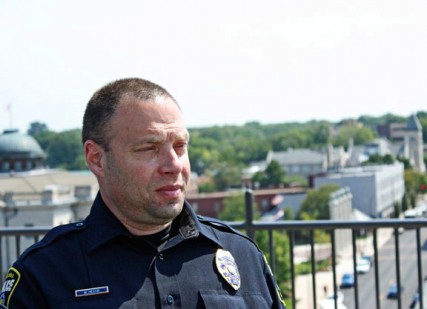
A few churches requested to hold these sessions for their congregations. Alive in Christ Lutheran Church held one this spring; First Christian Church in rural Centralia, Mo., will hold one in September.
Michael Hestir, a sergeant with the Columbia Police Department, is a training session leader. He has taught ALICE, an active shooter response plan, since 2009.
We sat down to talk about what people can do when faced with an active shooter. Answers have been edited for length.
From your experience, does it seem like most churches and schools have a plan?
I would love to say that after Columbine, everyone immediately said no way, never again. But that’s not true.
Walk me through a training session – what does that look like?
First what we try to do is educate people about what actually occurs. For instance, on television, if someone robs a bank or shoots someone, literally before that next commercial break, there’s an ambulance, police cars, SWAT team, helicopter – all those assets are right there. In real life, there’s a very big time delay. If there’s a shooting, you’re looking at a 10-minute response time.
The second thing we do is try to encourage people to be responsible for their own safety, and it seems maybe minor, but in today’s society, people are encouraged to wait on the police, wait on the ambulance. With these horrible events, active shooters, armed intruders, there’s not time to wait.
We encourage run, hide or fight. Run away if you can. Hide if you have a spot to. Turn off your cell phone so it doesn’t ring. And if you’re cornered, and you can’t get away, we encourage people to fight, and it’s literally a fight to the death.
What are the particular challenges facing rural areas, for both law enforcement and citizens?
Rural law enforcement, what they face is they don’t have 20 cops on the way. They might have four or five, from neighboring agencies. They have to notify everybody, they have to drive there and then they have to act. So buying time is probably the biggest challenge that citizens and officers face.
When it comes to the “fight” part, what recommendations do you have for people?
We rely on very primal basic instincts. We encourage people to throw stuff at the attacker. You will blink if something comes at your eye – it’s hardwired into your brain to protect your eye.
And we encourage people to follow that up with tackling, hitting. We teach the swarm technique, where three, five, 10, 15 people, instead of cowering in fear, jump on the guy.
We teach people to grab on to limbs. If a 100-pound woman grabs the suspect’s left arm, well his left arm now weighs 100 pounds more.
What else do you think is important for people to know?
People need to understand we’re not trying to prepare churchgoers or kids in schools to become ninjas. All we’re saying is if you’re cornered somewhere and can’t hide, can’t run away, it does not work to cower down and beg for mercy from these people.
As a last-ditch effort, go down swingin’. In fact, don’t go down. Just fight back.

Come back every day this week for parts two through five of the “Religion & Violence” series, here on favs.news.




